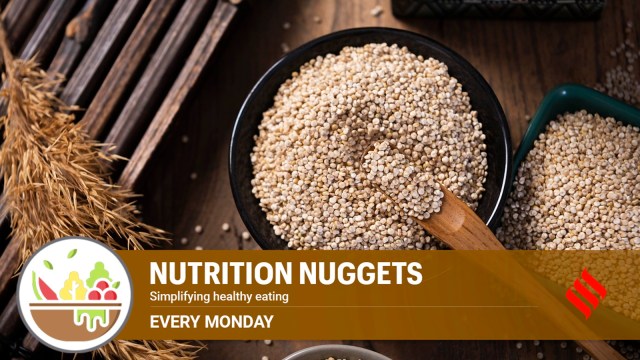Can quinoa be the magic superfood to control triglycerides?
How much should each age group have?
 Quinoa (Chenopodium quinoa) is a pseudo-cereal rich in fibre, protein, and essential nutrients. (Source: Pixabay)
Quinoa (Chenopodium quinoa) is a pseudo-cereal rich in fibre, protein, and essential nutrients. (Source: Pixabay)High triglycerides or the commonest fats circulating in your blood are a major risk factor for heart disease, metabolic syndrome, and type 2 diabetes. Dietary modifications play a crucial role in managing triglyceride levels and quinoa has gained attention as a heart-healthy food that can help control its levels.
The Science Behind Quinoa and Triglyceride Control
Quinoa (Chenopodium quinoa) is a pseudo-cereal rich in fibre, protein, and essential nutrients. It has a low glycemic index and contains bioactive compounds that contribute to lipid metabolism and cardiovascular health.
High Fibre Content – Soluble fibre helps reduce triglyceride levels by slowing down digestion and preventing rapid glucose spikes, which can trigger fat storage in the liver.
Rich in Omega-3 Fatty Acids – Quinoa contains small amounts of alpha-linolenic acid (ALA), which helps regulate blood lipids and reduces inflammation.
Plant-Based Protein – Unlike refined carbohydrates, quinoa provides protein that promotes satiety and helps in weight management, an important factor in triglyceride control and enhance metabolic health.
Magnesium and Antioxidants – Magnesium aids in insulin regulation, while antioxidants combat oxidative stress, which can contribute to high triglyceride levels.
How Much Quinoa to Consume Daily?
Moderation is key when incorporating quinoa into a triglyceride-lowering diet. The recommended daily intake varies based on an individual’s caloric needs and lifestyle:
For general heart health: ½ to 1 cup of cooked quinoa per day (approx. 50-100 grams)
How to Avoid Overconsumption
Despite its benefits, excess quinoa can lead to unintended effects such as weight gain, bloating, or excess calorie intake. To prevent overdoing it:
1) Stick to portion sizes and avoid eating quinoa in addition to other carbohydrate-rich foods like white rice or potatoes.
2) Balance it with vegetables, lean proteins, and healthy fats.
3) Ensure it replaces processed grains rather than adding extra calories to your diet.
Can people with gut issues have quinoa?
Some individuals experience bloating, gas, or digestive discomfort after eating quinoa due to its saponin content and fibre density.
Sensitive Gut or IBS: Start with small amounts (¼ cup cooked) and gradually increase to assess tolerance.
Saponin Sensitivity: Rinse quinoa thoroughly before cooking to remove natural bitter compounds that may cause irritation.
Low-Fibre Diet Needs: Opt for white quinoa, which is easier to digest compared to red or black varieties.
Age-Wise Recommendations for Quinoa Consumption
1. Children (5-12 years): Introduce in small portions (¼ to ½ cup cooked) as a healthy grain alternative. Mix with other foods like dal or yogurt for easy digestion.
2. Teenagers (13-18 years): ¾ cup cooked, depending on activity levels. Helps meet growing nutritional demands while promoting heart health.
3. Adults (19-50 years): ¾ to 1 cup cooked for those aiming to regulate triglycerides. Can be consumed in salads, soups, or as a rice replacement.
4. Older Adults (50+ years): ½ to ¾ cup cooked, focusing on easy digestibility. Combine with gut-friendly ingredients like curd or well-cooked vegetables.
(Narang is clinical Nutritionist, Apollo Hospital, Delhi)






- 01
- 02
- 03
- 04
- 05

























